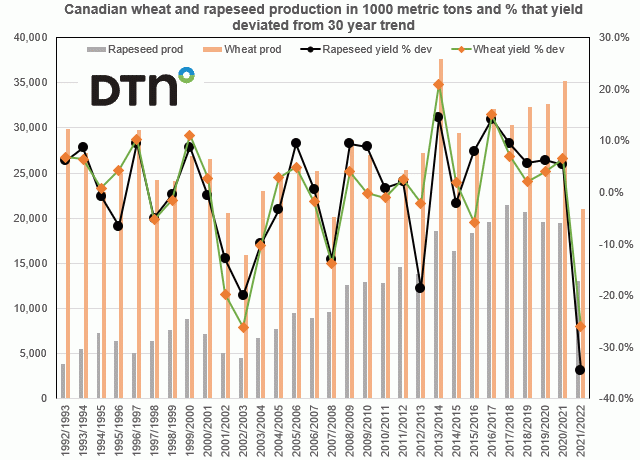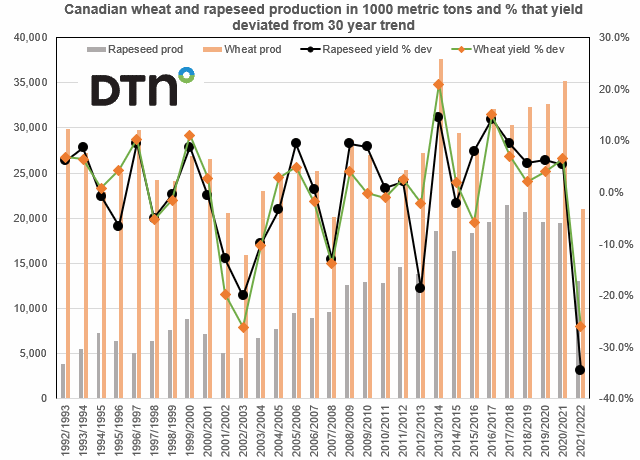Fundamentally Speaking
Canadian Drought Has Major Impact
When Stats Canada releases their updated 2021 production forecasts on December 3, it is possible they will show even lower wheat and canola output than what USDA has projected.
This is saying something given that USDA already has Canadian wheat and rapeseed production at the lowest levels in years and yields, as measured by percent deviation from trend among the worst ever.
This graphic shows Canadian wheat and rapeseed production in 1000 metric tons (mt) on the left-hand axis and the percent that yields for both crops deviates from 30-year trend on the right-hand axis.
In the November 2021 WASDE report, Canada's rapeseed output was pegged at 13.0 million metric tons (mmt) with a yield of 1.48 mt per hectare.
P[L1] D[0x0] M[300x250] OOP[F] ADUNIT[] T[]
The estimated yield is the lowest since 2003-04 and is a whopping 34.5% below trend.
This is the biggest negative deviation of yield from trend since 1990 and may be the largest negative deviation ever.
Meanwhile wheat production at 21 million tonnes, down hugely from the prior year's 35.2 million tonnes which was the second largest crop ever, is the lowest Canadian wheat crop since the 2007/08 season.
Their all-wheat yield at 2.47 mt per hectare is the lowest also since the 2007/08 marketing year but as a percent of trend basically matches the 2002/03 negative 26.1% deviation as the largest since 1992 and perhaps ever.
This enormous decline in what may be Canada's two most important crops has had a big impact on U.S. prices as our wheat imports come mostly from Canada and their lack of supplies had exacerbated the tightness in wheat supplies here.
Meanwhile the crash in Canadian rapeseed supplies has resulted in a further tightening of world vegetable oils and has also been one of the reasons for the near $70 surge in U.S. soybean meal prices over the past month due to limited supplies of canola meal that will be exported from Canada into the western U.S.
Canada perhaps even more so than the U.S. had one of their worst droughts in history and the final tally on their crops may result in further downgrades.
If incorporated into the next USDA supply-demand report due out December 9, this could accentuate an ongoing wheat rally where U.S. and global prices are at ten-year highs, and add further support to soybean oil already trading close to all-time highs, resulting in more soybean meal being fed linked to lower canola meal output.
(c) Copyright 2021 DTN, LLC. All rights reserved.






Comments
To comment, please Log In or Join our Community .